PGA Tour Rookie of the Year Cam Young shares his prime moves to help you blister the ball
Photographs by Jesse Rieser
Every bomber seems to have a signature move. For Rory, it’s fast hips. For DJ, it’s the bowed left wrist. For Rahm, it’s the short backswing. What’s Cam Young’s thing? You might say it’s the pause before he starts his downswing. That’s tough to ignore. However, the more you see his swing, the more your attention goes to its explosiveness. Young swings like he’s trying to turn the ball into dust.
“He did everything hard growing up – threw hard, hit baseballs hard, his ice hockey slapshot was hard, and so is his golf swing,” says Cam’s father, David Young, the recently retired head golf professional at Sleepy Hollow Country Club in New York. David also is Cam’s coach. “It wasn’t something we worked on. He just naturally knew how to use his body to crank it.”
That raw power has been refined to find more fairways, but Young still cranks it, averaging 289 metres (316 yards) off the tee on the PGA Tour this year.
Here father and son will reveal the components that create this power – and what you can take away for your game.
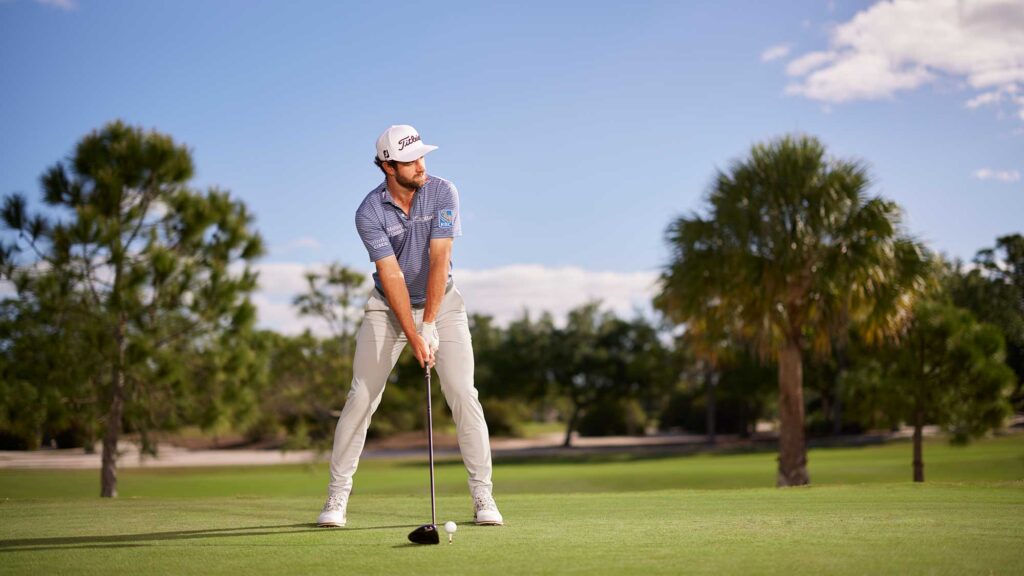

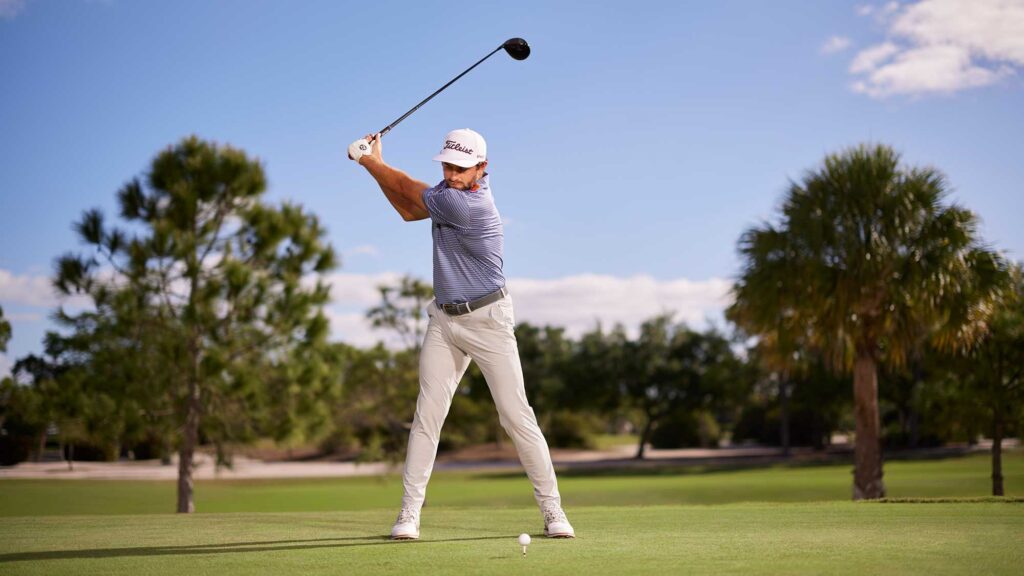
Start wide and stay wide – but remain centred
Young’s setup and backswing are fairly standard among power players, and there’s a lot you can copy. His wide, stable stance is neutral in relation to the target [above left], which leads to more consistency.
“I use the term ‘benchmarks’ for things in his stance and swing that are easy to copy. We want as many of those as he can create,” David says. “Think about it, if you’re not square, how do you know from swing to swing if you’re starting from the same position?”
The main thing to pay attention to in this phase of Cam’s swing is the width of his swing arc. While amateurs tend to have a narrow arc, taking the club back mostly with their arms, Cam stays very wide by moving his arms and torso together [above centre]. The wider the arc, the more time the club has to pick up speed in the downswing.
Also, note how his upper body remains centred over his lower body [above right]. In the past, a tendency to move more laterally led to inconsistencies in his ball-striking. Amateurs frequently make the same mistake. Now Young coils with his “legs under him. That’s a good swing thought,” he says.
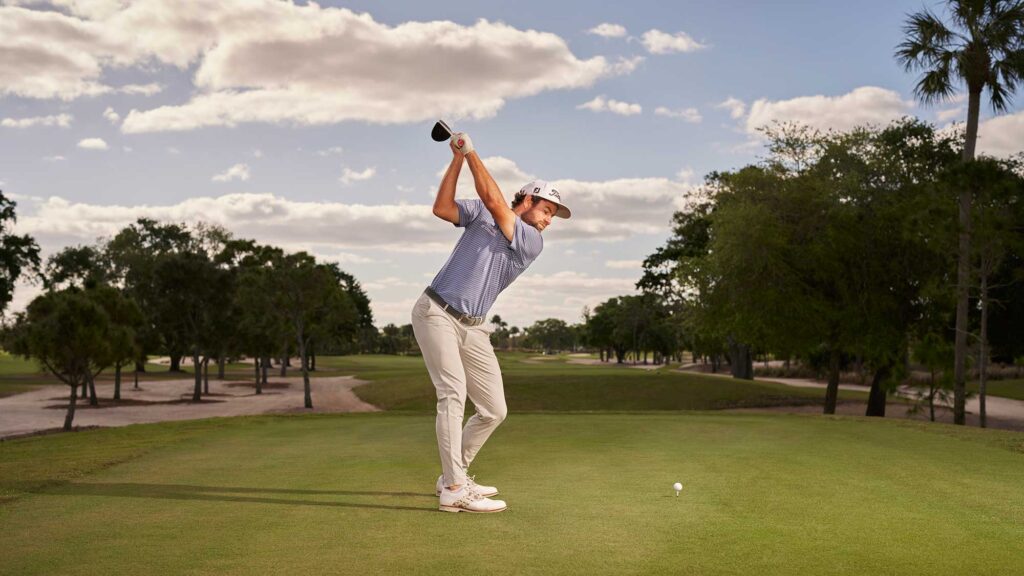
Turn back until your body tells you to stop
Cam says he has “no idea” where his backswing ends and downswing begins, but David says it’s the “easiest place to find” if you’re looking to improve your consistency: “When your body is fully wound, you’ll know it.” From that moment, Cam pauses for a fraction of a second, then starts down with everything he’s got. “We never trained that pause, but it does help with timing and sequencing,” David says. “For amateurs, I recommend trying it when you practise, even doing slow-motion drills where you feel very calm at the top of your swing.”
Another goal should be getting the club in position to swing down from inside the target line, not outside the line where the usual result is a weak, glancing hit. Note the space inside that Cam has created as he reaches the top [above].
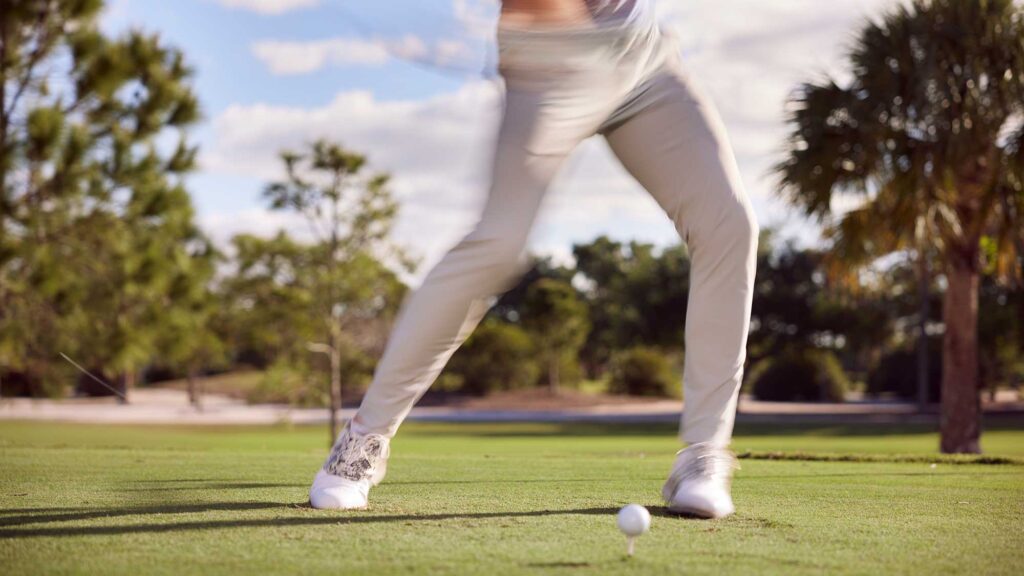
Use your legs like a sprinter
The most dynamic moves in Young’s swing come
from his lower body, and if you can copy them even just a bit, you’ll pick up a lot more speed. First, as his upper body is completing the backswing, note how his right foot “pushes off the blocks like a sprinter’s”, David says. That trail-leg push [above] can provide a real boost to how fast you can move the club back down into the ball.
The second move is one that can help golfers who start down to the ball with their arms first, a common mistake. Cam says he sometimes works on getting his left hip quickly moving at the target. The effect is that his left knee goes from pointing inside the ball at the top of the swing to pointing a foot or more in front of it halfway down. Copying this knee action helps prevent an arm-dominant swing.
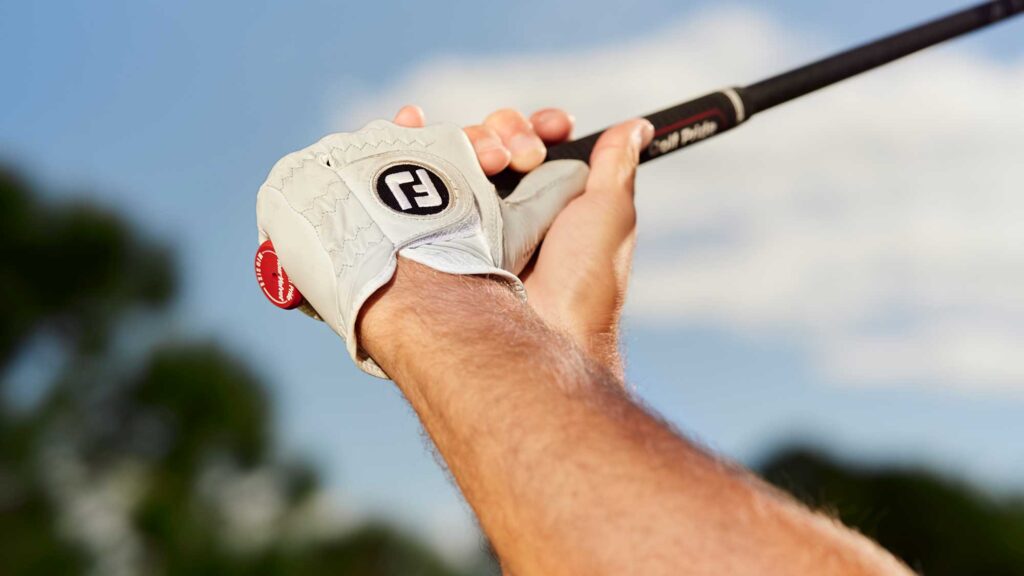
Put a firm grip on your club
If you think Young is gripping his driver as if he’s holding a baby bird, feel sorry for the bird. You might start from a tension-free address position with your arms and hands feeling relaxed, but to generate real speed on the way back down to the ball, you can’t hold onto the club like you’re afraid to break it, Cam says.
Because Cam’s body is largely supplying the energy of the strike, he needs a tight hold on the club to control it [above]. Amateurs are often given the “light grip” advice to help release the club through the impact zone, but there’s no need for that hand action if you control your swing mostly with body rotation.
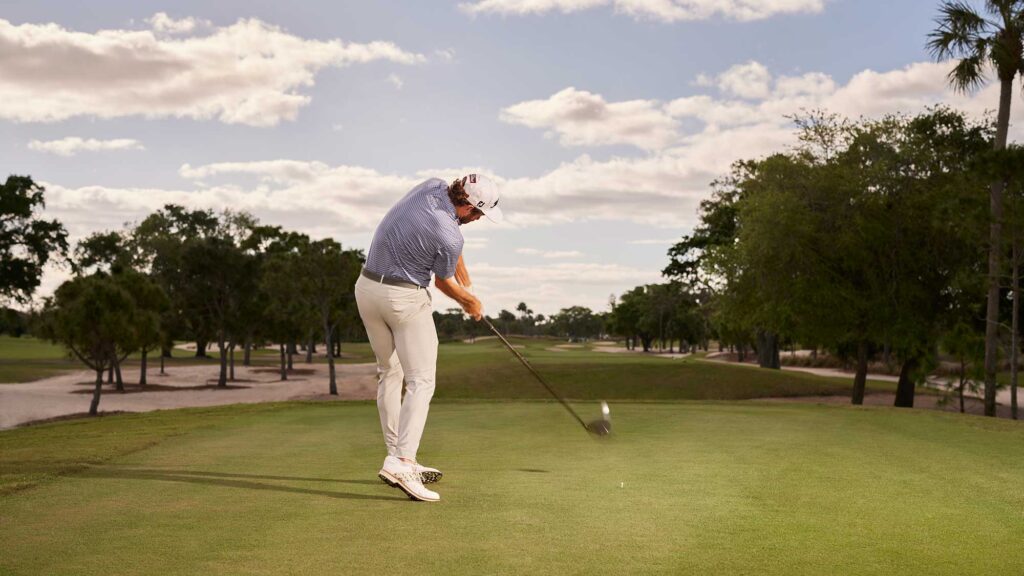
Keep turning, but stay behind the ball to launch it
Young prefers a draw for extra distance and gets it by making sure his clubface is slightly closed
(pointing left) of his inside-out swing path at impact. That closure comes from body rotation, not supination of the left forearm. “It’s much easier to repeat. It doesn’t require the split-second timing you need if you’re trying to close the clubface with your arms,” he says.
If you return to the photo that opened this article, you can see that Young, who is only 180 centimetres and 84 kilograms, is delivering the full mass of his body into the strike. Here, his right shoulder is key, as it moves downward [above] while his torso falls away from the target. This allows the club to launch the ball high with less backspin – two things you’ll need to do to make this your longest year ever!
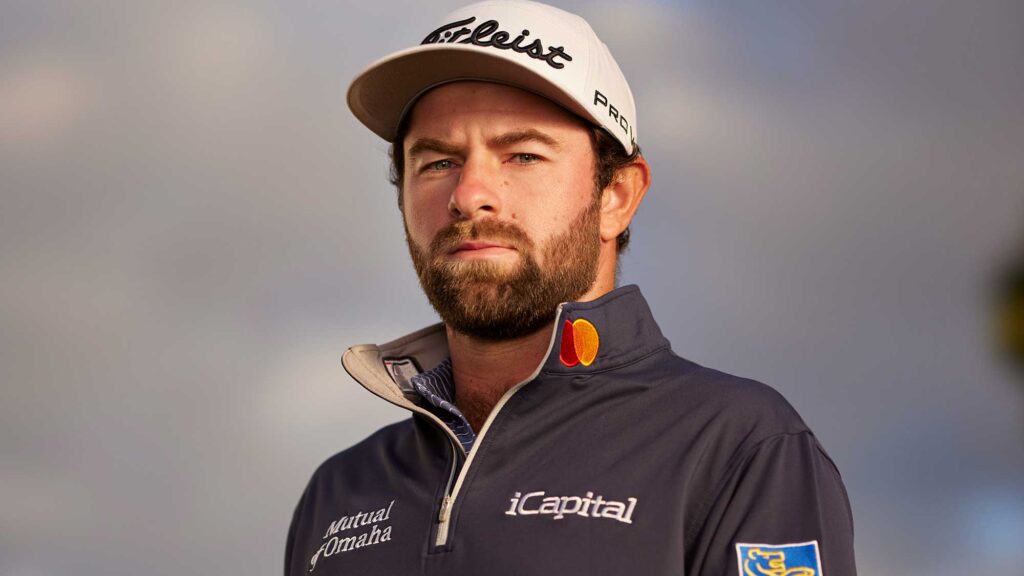
Smiling on the inside
Cam Young is having fun. Really, he is. You might not know it by the way he sometimes treats his golf clubs, and when he finishes a round, it’s hard to tell if he shot 66 or 86. But if your impression of the PGA Tour’s 2022 Rookie of the Year is that he’s miffed all the time, you’ve got it wrong.
Mostly.
“He’s the grumpiest nicest person I have ever met,” Will Zalatoris says.
Zalatoris, another of the PGA Tour’s rising stars, became friends with Young while they played at Wake Forest University, and the two have grown closer since. In fact, there’s a network of ex-Wake Forest players in the Jupiter, Florida, area who still hang around and play semi-competitive rounds with each other.
Ask any of them to describe the Young they met in college, and they’ll probably tell you he was quiet… until he wasn’t. There was the time when Young slammed his golf bag with a club, only to realise his once fully intact phone was inside, his teammates say. Cam also admits to breaking a shaft over his neck once, but that was years ago. Nowadays, assaults on golf equipment have been replaced mostly by looks of disgust between the gallery ropes, even when things seem to be OK.
“He’s the type of guy who can shoot a low number and could be complaining, but I love him,” Zalatoris says. “He’s got a heart of gold – one of my favourite people in the world.”
Adds former teammate Lee Detmer, who now plays on the PGA Tour Canada, “On the outside he might seem like an angry old fart, but he’s a very happy-go-lucky guy.”
Young says his resting grump face is the result of trying to curb emotion during tournaments – bad and good – and it seems to be helping his game. Although winless in his rookie year, Young had seven top-three finishes in 25 PGA Tour starts, including nearly winning the Open Championship (lost by a shot to Cameron Smith). This season, he finished runner-up to Sam Burns in the WGC–Dell Technologies Match Play. His rise has been so fast and impressive, he went from an Official World Golf Ranking of 1,500 in 2020 to 13 this year. That progress, becoming one of golf’s surprise success stories, should manifest in more grins than scowls, no?
“People think I’m more upset than I am,” says Young, who turned 26 in May. “I don’t smile a ton on the golf course, but that’s just my way of keeping myself in a mental headspace where I can do my job.”
Adds his father, David, “I think a lot of people would enjoy it more if he was up, acting happier, but he works hard at not showing it.”
There’s the Cam Young you know, and the Cam Young you don’t know, his friends say. The Cam Young you don’t know is now the quintessential family man, spending nearly all of his free time with his wife, Kelsey, and their two young sons, both under the age of 2. Although he was a multi-sport
athlete growing up, when asked about activities and hobbies he enjoys in his down time now, Young gives you that new-parent look of, Yeah, right.
“It’s golf and diapers,” he says.
Although Cam will probably never be anointed the life of any party, his family and friends say he does show more personality now. “It’s not much, but he did text me a pic of himself with a champagne bottle after they won the Presidents Cup last year,” Detmer says.
“He looks so darn serious, but he’s got a good sense of humour and really enjoys life,” says David, the former golf professional at Sleepy Hollow Country Club in New York. Cam grew up with that renowned course literally in his backyard. As an only child practising and playing a lot on his own, he says he learned to enjoy the solitude of the game and thinks it helped him develop as a golfer faster.
David can attest to his son’s drive for improvement, especially when it comes to fine-tuning one of the most powerful swings on the PGA Tour. Young ranks among the top five in average driving distance (289 metres/316 yards) and driver clubhead speed (123 miles per hour) but continually tries to refine his technique, counting heavily on dad’s feedback as he has since childhood. Scott McKean, Young’s former caddie and Wake Forest classmate, once described the way the father and son communicate as if they’re using “telepathy”.
Adds Detmer, “If you listen to them talk to each other, it’s like these low mumbles. You can barely understand them. But you can tell they’re really in tune with each other. There’s a lot of respect between the two.”
Cam says he learned a lot about the “profession” of golf by watching how his father handled himself, and it’s why he’s not taking anything about this opportunity for granted, even if that means winning fewer fans.
“People don’t realise, sometimes, that this is your job,” he says. “I love golf, and I love playing competitively, but it is a job, and I take it seriously. Sometimes smiling and waving to the crowd isn’t my first priority.”



